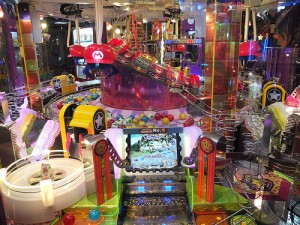On Friday the 16th, of December I interviewed Masayuki Uemura who is a Professor at Ritsumeikan since 2003, but is also known as the head of the division that designed the Famicom when he was at Nintendo. Professor Mitsuyuki Inaba translated for us as Professor Uemura doesn’t speak English and I don’t speak Japanese. We talked mostly about his current research into patterns of play.
Uemura and his lab have developed a system that captures play activity as subjects play video games. They simultaneously capture:
- Video of the game screen,
- Video of the player with a time and date stamp,
- Information about the number of times different controller buttons are pressed, and
- Video of a system of lights that shows what buttons are being pressed and the elapsed time.
This is combined into a single video with four squares so that they can review subjects playing and simultaneously see what they are doing. The controller buttons being pressed is also recorded as data that they can analyze. I asked if they had thought of capturing the controller data (when buttons are pressed and for how long) as MIDI and he said they tried that, but couldn’t get rid of latency in the capture. They are now experimenting with gathering more data like heart rate, but that is intrusive so they are also thinking of eye-tracking. The idea is to capture as much information about player behaviour as possible so as to compare players and try to understand differences between players. He is trying to see if there are types of players (like button mashers vs careful button pressers.) After they capture a subject playing they follow that up with an interview as he feels that there is a lot more to game playing than what happens on the screen. He would like to capture as much context as possible.
He talked about an interesting phenomenon where players repeatedly press a button that doesn’t do anything (the up in the cross-shaped joypad.) He showed me a slide with results of a test of 7 participants with the amount that they pressed the up button in 8 minute segments. Strangely the players that self-identified as experts pressed up a lot more. He has also been looking at when they press combinations of buttons. At the moment he is still gathering data and he is interested in cross-cultural comparisons of how players in different countries play the same games. He has gathered some data from Chinese players (who generally play pirated versions of games) to see if there are differences between Chinese and Japanese players. We talked about gathering data from Canadian players too.
While he described some of his preliminary findings, he was reluctant to speculate as to why there would be differences or why players would continue using a button that doesn’t do anything. It was clear to me that he wanted to be rigorous in the description of player behaviour and not indulge in speculation about the reasons for differences too early.
At the end of the interview (or I should say discussion) we talked a little bit about Nintendo. He has an article coming out in the journal of DiGRA Japan (Japanese) where he discusses his experiences at Nintendo and the development of the Famicom. He encouraged me to read that when it comes out.

